Green Wall and Green Roof Issues
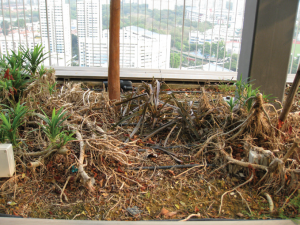
Dying plants on a green roof
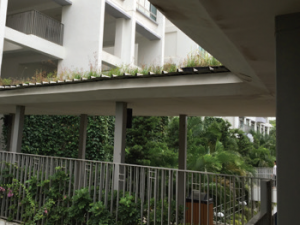
Vegetation planted at areas that are difficult to access for maintenance
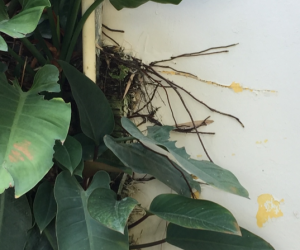
Root penetration through the wall structure
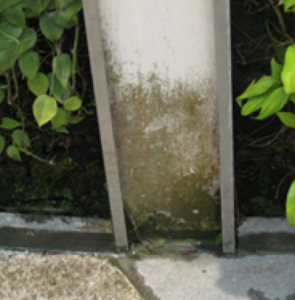
Water seepage on column
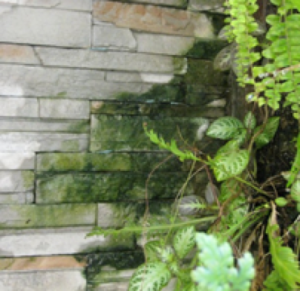
Biological growth on a green wall
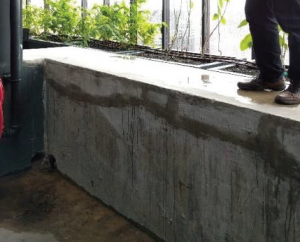
Access to vertical greenery is hampered by the height of the walkway ledge, where maintenance crew will need to climb onto it.
Design Guidelines
- The structural integrity of a green wall system should be certified by professional structural engineer. Safety and maintenance concerns should be thought of and addressed early, during the design stage [1].
- Frequency of maintenance and cost issues should be considered when selecting the plants and materials [2].
- Considerations for a safe environment rely mostly on matching the proper plant to the proper place [3].
- New gutters for green roofs should be provided with stainless steel leaf covers, and should be located at or less than 15mm above ground level (SS 525:2006) (See also BS EN 1253-2:2015).
- Adhere to proper specifications in waterproofing (SS 374:1994) to prevent water seepage on columns between two vertical greenery systems. (See also BS EN 13416:2001 and BS EN 12039:2016).
- Inaccessible or difficult to access green roof/green wall installations create issues in maintenance planning and execution. It has implications for labour costs such as increased man hours and the resultant higher cost. They also pose safety risks triggered by the lack of access and safety provisions [4].
Construction Guidelines
- The constructed roof garden should not allow plant roots to damage the building structure (e.g. roof waterproofing membrane) [5]. Safe work schedules to be followed with proper equipment and site supervision. Especially to prevent falls from heights and falling objects [2].
- Inspect plants carefully upon their arrival at the site for damage to leaves/ stems and broken branches during transport and handling. The landscape contractor should refer to the plant list for seasonal requirements related to the time of planting, and to contract specifications for additional requirements [3].
- Use of sharp and extremely angular grained aggregates, which can affect the stability of material during installation, is discouraged. Installation of staking and guying can take reference from the methods and standards specified in the latest ANSI A300 Part 3 and should be read in conjunction with the rest of the ANSI A300 when carrying out such installations (ANSI A300:2017).
- Maintain construction quality control during the installation of green roof and green wall component (e.g. fixtures and fittings and vegetation plantings).
Maintenance Guidelines
- Prevent obstruction of structural elements to ensure easy periodic maintenance. Conduct periodic inspection of supporting structures [6].
- Hardy plants that require less water and sunlight (especially for those installed in
indoor environments) and routine maintenance practices are required in roof garden maintenance [7]. - Monitor conditions on a regular basis to head off problems such as insect attacks, irrigation, disease or soil problems. Refer to the ANSI standards for pruning (ANSI A300:2017); and ANSI safety requirements for tree care operations (ANSI Z133:2012) [3].
- Rainwater pipe works, gutters and gratings on green roofs should be inspected and thoroughly cleaned annually (SS 525:2006).
- The drip irrigation piping should preferably have provisions to counter plant-room
penetration as plant roots may clog up drip holes [4]. - Conduct annual or semi-annual inspections to control or prevent bird interaction with vertical greenery system (VGS), for plant survival must be taken into account. To minimise evaporation losses, water the plants between 4–7am or 6–9pm [8].
References
[1] Centre for Urban Greenery and Ecology (2014). Guidelines on Design for Safety of Skyrise Greenery. Singapore: National Parks Board.
[2] Centre for Urban Greenery and Ecology (2013). A Concise Guide to Safe Practices for Rooftop Greenery. Singapore: National Parks Board.
[3] Harris, C.W. and Dines, N.T. (1998). Time Saver Standards for Landscape Architecture: Design and Construction Data (2nd ed.). USA: McGraw-Hill.
[4] NUS Maintainability of Buildings (2017). Roof/Sky Garden. Retrieved on May 9 from http://www. hpbc. bdg. nus.edu.sg/?page_id=963.
[5] Centre for Urban Greenery and Ecology (2012). Guidelines on Waterproofing for Rooftop Greenery. Singapore: National Parks Board.
[6] Centre for Urban Greenery and Ecology (2013). A Concise Guide to Safe Practices for Vertical Greenery. Singapore: National Parks Board.
[7] Centre for Urban Greenery and Ecology (2012). Guidelines on General Maintenance for Rooftop Greenery. Singapore: National Parks Board.
[8] NUS Maintainability of Buildings (2017). Vertical Greenery. Retrieved on May 9 from http://www. hpbc. bdg. nus.edu.sg/?page_id=962.
Normative References/Standards Referred to for Green Wall and Green Roof
• ANSI A300:2017 — Tree, Shrub, and Other Woody Plant Management — Standard Practices (Pruning)
• ANSI Z133-2012 — Safety Requirements for Arboricultural Operations
• BS EN 12039:2016 — Flexible sheets for waterproofing. Bitumen sheets for roof waterproofing. Determination of adhesion of granules
• BS EN 1253-2:2015 — Gullies for buildings. Roof drains and floor gullies without trap
• BS EN 13416:2001 — Flexible sheets for waterproofing. Bitumen, plastic and rubber sheets for roof waterproofing. Rules for sampling
• SS 525:2006 — Code of practice for drainage of roofs